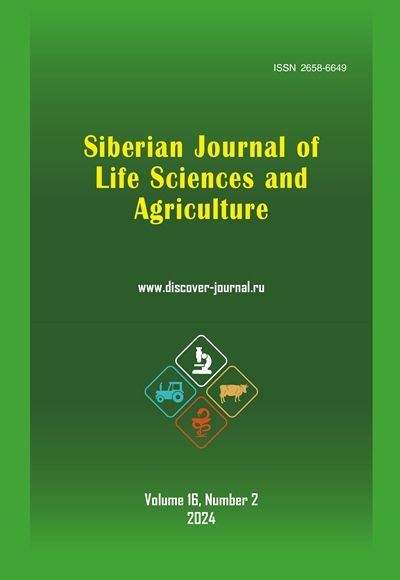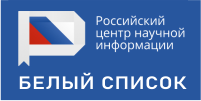ЦИТОГЕНЕТИЧЕСКИЕ ЭФФЕКТЫ Y-РАДИАЦИИ В КЛЕТКАХ КОРНЕВОЙ МЕРИСТЕМЫ ALLIUM CEPA
Аннотация
Обоснование. Загрязнение окружающей среды радиоактивными материалами геогенного и антропогенного происхождения является глобальной проблемой. Было разработано множество процедур тестирования на мутагенность, которые позволяют обнаруживать повреждения ДНК, вызванные ионизирующим излучением. В настоящей работе использовали Allium - тест (широко используемый биоанализ генотоксичности на основе растений) для выявления генетических повреждений, вызванных y-излучением. Полученные данные указывают на то, что данный метод может быть использован для биомониторинга окружающей среды. Целью настоящего исследования было изучение y-излучения с помощью Аллиум-теста.
Материалы и методы. Луковицы лука Штутгартер Ризен (Allium cepa L., 2n = 16) хранили в темном прохладном месте (+4-5°C). Для каждого образца и контроля брали по 3 луковицы. В качестве контроля использовали дистиллированную воду. Гамма-облучение проводили с помощью Eu152 в течение 3 дней в дозах 0,3, 1 и 3 Гр. Через 3 дня корни срезали и фиксировали в уксусном алкоголе, а затем помещали в герметичные пробирки для длительного хранения в 80%-ном этаноле. Корни гидролизовали и окрашивали в керамических тиглях в растворе ацетоорцеина над пламенем спиртовки, а давленые препараты готовили в капле 45%-ной уксусной кислоты. Количество делящихся клеток определяли в 1000 клеток в поле зрения с учетом фаз и хромосомных аберраций.
Результаты. Было выявлено появление гигантских клеток, С-митозов, ядерных почек, фрагментов, отставаний и мостов, нарушений в работе веретена деления и микроядер при облучении в дозах 3 и 1 Гр.
Выводы. В результате исследования было показано, что y - облучение лука репчатого (Allium cepa L.) дозами 3, 1 и 0,3 Гр приводило к появлению цитогенетических нарушений, доля которых достоверно отличалась от контроля.
Скачивания
Литература
Список литературы
Буторина А. К., Калаев В. Н. Анализ чувствительности различных критериев цитогенетического мониторинга // Экология. 2000. №3. С. 206-210.
Калаев В. Н., Попова А. А. Цитогенетические характеристики и морфологические показатели семенного потомства деревьев дуба черешчатого (Quercus robur L.), произрастающих на территориях с разным уровнем антропогенного загрязнения // Вестник Воронежского государственного университета. Серия: Химия. Биология. Фармация. 2014. №4. С. 63-72.
Трофимова Е. А., Дементьев Д. В., Болсуновский А. Я. Влияние γ-излучения на развитие растений из облученных семян и проростков Allium cepa L // Радиационная биология. Радиоэкология. 2019. Т. 59, № 3. С. 293-299.
Barbério A., Barros L., Voltolini J. C., Mello M. L. S. Evaluation of the cytotoxic and genotoxic potential of water from the Brazilian river Paraíba do Sul with the Allium cepa test // Brazilian Journal of Medical and Biological Research. 2009. Vol. 69(3). P. 837-842. https://doi.org/10.1007/s11051-013-2220-2
Bonciu E., Firbas P., Fontanetti C. S., Wusheng J., Karaismailoğlu M. C., Liu D., Menicucci F., Pesnya D. S., Popescu A., Romanovsky A. V., Schiff S., Ślusarczyk J., de Souza C. P., Srivastava A., Sutan A. N. Papini A. An evaluation for the standardization of the Allium cepa test as cytotoxicity and genotoxicity assay // Caryologia. 2018. Vol. 71. P. 191-209. https://doi.org/10.1080/00087114.2018.1503496
Bonea D., Bonciu E. Cytogenetic effects induced by the fungicide Royal Flo to maize (Zea mays L.) // Caryologia. 2017. Vol. 70(3). P. 195-199. https://doi.org/10.1080/00087114.2017.1318232
Ennaceur S. Genotoxicity assessment of drinking water from different sources using the Allium cepa test procedure // Fresenius environmental bulletin. 2018. Vol. 27(12B). P. 9972-9978.
Fesenko S. V., Alexakhin R. M., Geras'kin S. A., Sanzharova N. I., Spirin Y. V., Spiridonov S. I., Gontarenko I. A., Strand P. Comparative radiation impact on biota and man in the area affected by the accident at the Chernobyl nuclear power plant // J. Environ. Radioact. 2005. Vol. 80. P. 1e25. https://doi.org/10.1016/j.jenvrad.2004.08.011
Fiskesjo G. The Allium test as a standard for environmental monitoring // Hereditas. 1985. Vol. 102. P. 99-112.
Fiskesjo G. The Allium test—an alternative in environmental studies: the relative toxicity of metal ions // Mutat. Res. Fund. Mol. M. 1988. Vol. 197. P. 243-260.
Hamlin H. J., Guillette L. J. Jr. Birth defects in wildlife: the role of environmental contaminants as inducers of reproductive and developmental dysfunction // Syst. Biol. Reprod. Med. 2010. Vol. 56. P. 113-121. https://doi.org/10.3109/19396360903244598
Kursheed S., Raina A., Amin Laskar R., Khan S. Effect of gamma radiation and EMS on mutation rate, their effectiveness and efficiency in faba bean (Vicia faba L.) // Caryologia. 2018. Vol. 71 (4). P. 397-404. https://doi.org/10.1080/00087114.2018.1485430
Misík M., Krupitza G., Misíkova K., Micieta K., Nersesyan A., Kundi M., Knasmueller S. The Tradescantia micronucleus assay is a highly sensitive tool for the detection of low levels of radioactivity in environmental samples // Environmental Pollution. 2016. Vol. 219. P. 1044-1048. http://dx.doi.org/10.1016/j.envpol.2016.09.004
Mushtaq W., Ain Q., Siddiqui M. B., Hakeem K. R. Cytotoxic allelochemicals induce ultrastructural modifications in Cassia tora L. and mitotic changes in Allium cepa L.: a weed versus weed allelopathy approach // Protoplasma. 2019. Vol. 256. P. 857-871. https://doi.org/10.1007/s00709-018-01343-1
Palmieri M. J., Andrade-Vieira L. F., Cardoso T. M. V., De Faria E. M. W., Luber J., Davide L. C., Marcussi S. Cytogenotoxic effects of spent pot liner (spl) and its main components on human leukocytes and meristematic cells of Allium cepa // Water Air Soil Pollut. 2016. Vol. 227 (156). P. 1-10. https://doi.org/10.1007/s11270-016-2809-z
Richardson D. B., Cardis E., Daniels R. D., Gillies M., O'Hagan J. A., Hamra G. B., Haylock R., Laurier D., Leuraud K., Moissonnier M., Schubauer-Berigan M. K., Thierry-Chef I., Kesminiene A. Risk of cancer from occupational exposure to ionising radiation: retrospective cohort study of workers in France, the United Kingdom, and the United States (INWORKS) // BMJ. 2015. Vol. 351. P. h5359. https://doi.org/10.1136/bmj.h5359
Sartaj A. B., Guangyu C., Fusheng L., Adarsh P. V. Biomonitoring of genotoxicity of industrial wastes using plant bioassays // Bioresource Technology Reports. 2012. Vol. 6. P. 207-216. https://doi.org/10.1016/j.biortech.2018.01.003
Spycher B. D., Lupatsch J. E., Zwahlen M., Roosli M., Niggli F., Grotzer M. A., Rischewski J., Egger M., Kuehni C. E. Background ionizing radiation and the risk of childhood cancer: a census-based nationwide cohort study // Environ. Health Perspect. 2015. Vol. 123. P. 622e628. https://doi.org/10.1289/ehp.1408548
Sudhakar R., Ninge Gowda K. N., Venu G. Mitotic abnormalities induced by silk dyeing industry effluents in the cells of Allium cepa // Cytologia. 2001. Vol. 66(3). P. 235-239. https://doi.org/10.1508/cytologia.66.235
WHO. World Health Organization monographs on selected medicinal plants // World Health Organization. Geneva. 1999. Vol. 1. 193 p.
References
Butorina A.K., Kalaev V.N. Sensitivity analysis of different criteria of cytogenetic monitoring. Ekologiya [Ecology], 2000, no. 3, pp. 206-210.
Kalaev V.N., Popova A.A. Cytogenetic characteristics and morphological indices of seed progeny of trees of oak (Quercus robur L.) growing in areas with different levels of anthropogenic pollution. Vestnik Voronezhskogo gosudarstvennogo universiteta. Seriya: Khimiya. Biologiya. Farmatsiya, 2014, no. 4, pp. 63-72.
Trofimova E. A., Dementiev D. V., Bolsunovsky A. Y. Effect of γ-radiation on the development of plants from irradiated seeds and seedlings of Allium cepa L. Radiatsionnaya biologiya. Radioekologiya [Radiation Biology. Radioecology], 2019, vol. 59, no. 3, pp. 293-299.
Barbério A., Barros L., Voltolini J.C., Mello M.L.S. Evaluation of the cytotoxic and genotoxic potential of water from the Brazilian river Paraíba do Sul with the Allium cepa test. Brazilian Journal of Medical and Biological Research, 2009, vol. 69(3). pp. 837-842. https://doi.org/10.1007/s11051-013-2220-2
Bonciu E., Firbas P., Fontanetti C. S., Wusheng J., Karaismailoğlu M. C., Liu D., Menicucci F., Pesnya D.S., Popescu A., Romanovsky A.V., Schiff S., Ślusarczyk J., de Souza C. P., Srivastava A., Sutan A. N. Papini A. An evaluation for the standardization of the Allium cepa test as cytotoxicity and genotoxicity assay. Caryologia, 2018, vol. 71, pp. 191-209. https://doi.org/10.1080/00087114.2018.1503496
Bonea D., Bonciu E. Cytogenetic effects induced by the fungicide Royal Flo to maize (Zea mays L.). Caryologia, 2017, vol. 70(3), pp. 195-199. https://doi.org/10.1080/00087114.2017.1318232
Ennaceur S. Genotoxicity assessment of drinking water from different sources using the Allium cepa test procedure. Fresenius environmental bulletin, 2018, vol. 27(12B), pp. 9972-9978.
Fesenko S.V., Alexakhin R.M., Geras'kin S.A., Sanzharova N.I., Spirin Y.V., Spiridonov S.I., Gontarenko I.A., Strand P. Comparative radiation impact on biota and man in the area affected by the accident at the Chernobyl nuclear power plant. J. Environ. Radioact, 2005, vol. 80, 1e25. https://doi.org/10.1016/j.jenvrad.2004.08.011
Fiskesjo G. The Allium test as a standard for environmental monitoring. Hereditas, 1985, vol. 102, pp. 99-112.
Fiskesjo G. The Allium test—an alternative in environmental studies: the relative toxicity of metal ions. Mutat. Res. Fund. Mol. M, 1988, vol. 197, pp. 243-260.
Hamlin H.J., Guillette L.J.Jr. Birth defects in wildlife: the role of environmental contaminants as inducers of reproductive and developmental dysfunction. Syst. Biol. Reprod. Med, 2010, vol. 56, pp. 113-121. https://doi.org/10.3109/19396360903244598
Kursheed S., Raina A., Amin Laskar R., Khan S. Effect of gamma radiation and EMS on mutation rate, their effectiveness and efficiency in faba bean (Vicia faba L.). Caryologia, 2018, vol. 71, no. 4, pp. 397-404. https://doi.org/10.1080/00087114.2018.1485430
Misík M., Krupitza G., Misíkova K., Micieta K., Nersesyan A., Kundi M., Knasmueller S. The Tradescantia micronucleus assay is a highly sensitive tool for the detection of low levels of radioactivity in environmental samples. Environmental Pollution, 2016, vol. 219, pp. 1044-1048. http://dx.doi.org/10.1016/j.envpol.2016.09.004
Mushtaq W., Ain Q., Siddiqui M.B., Hakeem K.R. Cytotoxic allelochemicals induce ultrastructural modifications in Cassia tora L. and mitotic changes in Allium cepa L.: a weed versus weed allelopathy approach. Protoplasma, 2019, vol. 256, pp. 857-871. https://doi.org/10.1007/s00709-018-01343-1
Palmieri M.J., Andrade-Vieira L.F., Cardoso T.M. V., De Faria E.M.W., Luber J., Davide L.C., Marcussi S. Cytogenotoxic effects of spent pot liner (spl) and its main components on human leukocytes and meristematic cells of Allium cepa. 2016, Water Air Soil Pollut, vol. 227, no. 156, pp. 1-10. https://doi.org/10.1007/s11270-016-2809-z
Richardson D.B., Cardis E., Daniels R.D., Gillies M., O'Hagan J.A., Hamra G.B., Haylock R., Laurier D., Leuraud K., Moissonnier M., Schubauer-Berigan M. K., Thierry-Chef I., Kesminiene A. Risk of cancer from occupational exposure to ionising radiation: retrospective cohort study of workers in France, the United Kingdom, and the United States (INWORKS). BMJ, 2015, vol. 351, P. h5359. https://doi.org/10.1136/bmj.h5359
Sartaj A. B., Guangyu C., Fusheng L., Adarsh P. V. Biomonitoring of genotoxicity of industrial wastes using plant bioassays. Bioresource Technology Reports, 2012, vol. 6, pp. 207-216. https://doi.org/10.1016/j.biortech.2018.01.003
Spycher B.D., Lupatsch J.E., Zwahlen M., Roosli M., Niggli F., Grotzer M.A., Rischewski J., Egger M., Kuehni C.E. Background ionizing radiation and the risk of childhood cancer: a census-based nationwide cohort study. Environ. Health Perspect, 2015, vol. 123, 622e628. https://doi.org/10.1289/ehp.1408548
Sudhakar R., Ninge Gowda K.N., Venu G. Mitotic abnormalities induced by silk dyeing industry effluents in the cells of Allium cepa. Cytologia, 2001, vol. 66, no. 3, pp. 235-239. https://doi.org/10.1508/cytologia.66.235
WHO. World Health Organization monographs on selected medicinal plants. World Health Organization, Geneva, 1999, vol. 1, 193 p.
Просмотров аннотации: 220 Загрузок PDF: 178
Copyright (c) 2024 Maria V. Smirnova, Andrey A. Smirnov

Это произведение доступно по лицензии Creative Commons «Attribution-NonCommercial-NoDerivatives» («Атрибуция — Некоммерческое использование — Без производных произведений») 4.0 Всемирная.






















































